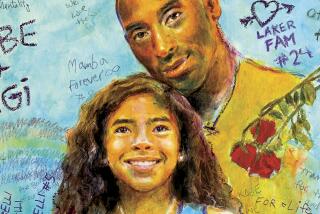Kobe Bryant helicopter pilot dismissed weather concerns before crash, NTSB documents show

- Share via
The night before Kobe Bryant’s final helicopter flight, the broker arranging the former Lakers star’s trip to Camarillo expressed concern to the pilot that “weather could be an issue.”
The next morning, the pilot, Ara Zobayan, assured the broker and Bryant’s personal drivers that the weather conditions “should be OK,” according to text messages made public Wednesday by the National Transportation Safety Board.
An hour and half later, Zobayan, Bryant, his daughter and six other people on board the helicopter were killed when the craft plunged into a fog-shrouded hillside above Calabasas.
The text messages are among the findings in 1,700 pages of documents that federal regulators released Wednesday. The records draw no conclusions about the cause of the crash, but they offer the most comprehensive account to date of Bryant’s final flight, which took off from John Wayne Airport in Orange County the morning of Jan. 26 and slammed into a hillside 39 minutes later, killing everyone on board.
NTSB investigators have interviewed virtually everyone who had some role in ferrying Bryant through Southern California’s skies, from the mechanic who maintained his favored helicopter, to the broker who arranged his travel, to Bryant’s personal assistant, Catherine Brady.
Brady told the NTSB that while Bryant’s 13-year-old daughter, Gianna, had games scheduled on the 26th for noon and 2 p.m., Bryant had asked her to move up his departure time, from 9:45 a.m. to 9 a.m., because he had wanted to watch another team play.
The morning of the 26th, a Sikorsky S-76B, operated by Island Express Helicopters, was waiting for Bryant at John Wayne Airport. Zobayan took off at 9:06 a.m., carrying Bryant, Gianna and six others: Christina Mauser; Payton and Sarah Chester; John, Keri and Alyssa Altobelli.
At 9:44 a.m., Zobayan, who was hugging the 101 Freeway near Calabasas, informed an air traffic controller he intended to climb above the cloud layer, Marie Moler, an NTSB aircraft performance specialist, wrote in a report released Wednesday. Zobayan began to climb and then banked left, straying from the 101, Moler wrote.
Zobayan, she said, may have “misperceived both pitch and roll angles”: While he told an air traffic controller he was climbing to 4,000 feet, he in fact was descending “rapidly while in a left turn,” the report said.
“When a pilot misperceives attitude and acceleration,” Moler wrote, “it is known as the ‘somatogravic illusion’ and can cause spatial disorientation.”
The Sikorsky slammed into a hillside at 184 mph, strewing wreckage across an area the size of a football field.
Four minutes later, the broker who arranged the flight asked Whitney Bagge, the vice president of Island Express Helicopters, to check the flight’s status, Bagge told the NTSB. She saw that a flight tracker had lost Zobayan at 9:45 a.m. As she tried to reach Zobayan over the radio, Bagge said she “kept refreshing the tracker praying that it was just broken.”
More to Read
Sign up for Essential California
The most important California stories and recommendations in your inbox every morning.
You may occasionally receive promotional content from the Los Angeles Times.











